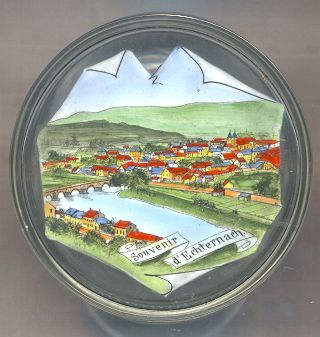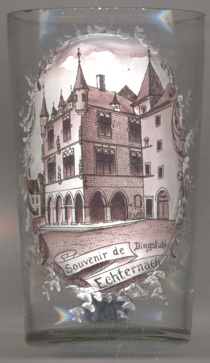

|
|
|
|
|
|
Echternach is situated at an elevation of 175 m on the right bank of the river Sauer (French: Sûre) which forms the border between Luxembourg and Germany. It is the centre of the canton Echternach and until 2015, when the three administrative districts were dissolved, was part of the district Grevenmacher. It is one of the oldest towns in Luxembourg. Its current population is about 5,600 (2019).
 The origins of Echternach go back to the times of the Romans who at this place had built a bridge across the river.
The Roman villa outside Echternach dates from the 1st century AD and is one of the largest (1.5 ha) of its kind north of the Alps.
The present town began to grow around the walls of the abbey of Echternach, which was founded iby St. Willibrord in 698 AD.
Echternach was granted a town charter in 1236.
After the dissolution of the abbey in 1797 the town declined. Only when the railroad reached Echternach
in the second half of the 19th century, tourism provided a new source of income for Echternach.
The picturesque town is still surrounded by the original medieval walls with towers.
Although badly damaged during World War II, the town was thoroughly restored between 1950 and 1955.
The origins of Echternach go back to the times of the Romans who at this place had built a bridge across the river.
The Roman villa outside Echternach dates from the 1st century AD and is one of the largest (1.5 ha) of its kind north of the Alps.
The present town began to grow around the walls of the abbey of Echternach, which was founded iby St. Willibrord in 698 AD.
Echternach was granted a town charter in 1236.
After the dissolution of the abbey in 1797 the town declined. Only when the railroad reached Echternach
in the second half of the 19th century, tourism provided a new source of income for Echternach.
The picturesque town is still surrounded by the original medieval walls with towers.
Although badly damaged during World War II, the town was thoroughly restored between 1950 and 1955.
 Echternach abbey [left, no. 1851: background right] was founded by
St. Willibrord in 698 AD.
Willibrord was an English monk of Ripon, who became the first bishop of Utrecht and worked to christianize the Frisians.
As bishop, he directed the monastery as abbot until his death in 739.
Between 659 and 971 the monks were displaced by secular canons of the bishop of Trier.
The original buildings were destroyed by a large fire, but the Romanesque basilica (completed in 1031, rebuilt around 1250)
still houses Willibrord's tomb in its crypt. In 1737 the basilica was rebuilt in Baroque style.
Sixty years later, in 1797, the monks were dispersed and the abbey's treasures and its famous library were auctioned off.
Some of the library's early manuscripts are today found in the Bibliothèque Nationale in Paris,
the 'Golden Bible' (Codex Aureus Epternacensis) today is housed in the Germanisches Nationalmuseum in Nuremberg,
the Codex Aureus Escorialensis is exhibited in the Escorial near Madrid.
The abbey was then converted into a porcelain manufacture and only was restored to a church in 1861.
The monastery today also runs a grammer school.
The church gained the status of a Basilica minor in 1939.
Echternach abbey [left, no. 1851: background right] was founded by
St. Willibrord in 698 AD.
Willibrord was an English monk of Ripon, who became the first bishop of Utrecht and worked to christianize the Frisians.
As bishop, he directed the monastery as abbot until his death in 739.
Between 659 and 971 the monks were displaced by secular canons of the bishop of Trier.
The original buildings were destroyed by a large fire, but the Romanesque basilica (completed in 1031, rebuilt around 1250)
still houses Willibrord's tomb in its crypt. In 1737 the basilica was rebuilt in Baroque style.
Sixty years later, in 1797, the monks were dispersed and the abbey's treasures and its famous library were auctioned off.
Some of the library's early manuscripts are today found in the Bibliothèque Nationale in Paris,
the 'Golden Bible' (Codex Aureus Epternacensis) today is housed in the Germanisches Nationalmuseum in Nuremberg,
the Codex Aureus Escorialensis is exhibited in the Escorial near Madrid.
The abbey was then converted into a porcelain manufacture and only was restored to a church in 1861.
The monastery today also runs a grammer school.
The church gained the status of a Basilica minor in 1939.
(see also list of other basilicae minores depicted on glasses of this collection)
 Until the 19th century, the
Until the 19th century, the  bridge acrosse the river Sauer [left, no. 1851: left] was thought to be of Roman origin,
although proof for this assumption is absent. In the 16th and 17the century remains of Roman tombstones were discovered in the pillars of the bridge;
however it is more likely that they have been used as building material only. A painting of the bridge dating from the 17th century still shows it
with six arches. One of these, the last one on the Echternach side, was filled in in 1870 when the Prince Henry Railroad
(named for Prince Hendrik of Oranje-Nassau, governor of Luxembourg) was built. On 12 September 1944, the German Wehrmacht blew up the bridge.
After the war, a preliminary bridge was constructed just north of the remains of the old bridge. A new bridge was then constructed in 1950.
bridge acrosse the river Sauer [left, no. 1851: left] was thought to be of Roman origin,
although proof for this assumption is absent. In the 16th and 17the century remains of Roman tombstones were discovered in the pillars of the bridge;
however it is more likely that they have been used as building material only. A painting of the bridge dating from the 17th century still shows it
with six arches. One of these, the last one on the Echternach side, was filled in in 1870 when the Prince Henry Railroad
(named for Prince Hendrik of Oranje-Nassau, governor of Luxembourg) was built. On 12 September 1944, the German Wehrmacht blew up the bridge.
After the war, a preliminary bridge was constructed just north of the remains of the old bridge. A new bridge was then constructed in 1950.
The  Denzelt [right, no. 3191] is the historical Dingstuhl,
the medieval court building of the town. The date of its origin is not exactly know. The building of 1374 was destroyed
by a fire in 1444 and was rebuilt thereafter in late Gothic style. After another fire in 1705, Baroque elements were
added to the façade. Further additions in Gothic revival style, including the statues of the four cardinal virtues
(Prudence, Fortitude, Temperance and Justice), of Our Lady, King Solomon and Abbot Robert de Montrél, followed
in 1895/96. During World War II the building suffered damages, but was restored after the war. Since 1974 the
Denzelt is protected as a National Monument.
Denzelt [right, no. 3191] is the historical Dingstuhl,
the medieval court building of the town. The date of its origin is not exactly know. The building of 1374 was destroyed
by a fire in 1444 and was rebuilt thereafter in late Gothic style. After another fire in 1705, Baroque elements were
added to the façade. Further additions in Gothic revival style, including the statues of the four cardinal virtues
(Prudence, Fortitude, Temperance and Justice), of Our Lady, King Solomon and Abbot Robert de Montrél, followed
in 1895/96. During World War II the building suffered damages, but was restored after the war. Since 1974 the
Denzelt is protected as a National Monument.
One of the best-known tourist attractions on Echternach is the "Dancing Procession" which takes places on Tuesday after Pentecost. The procession honours St. Willibrord. Thousands of pilgrims, divided into about 50 groups, dance to his tomb in the abbey to the tunes and rhythms played by an equal number of music bands. The origin of this cult and procession is largely unknown. Since 1975 Echternach is also the place of an annual festival of classical music.
The houses depicted in the foreground of the picture on glass no. 1851 [above left] today are part of
Echternacherbrück, Germany.
![[scale]](lineal.jpg)